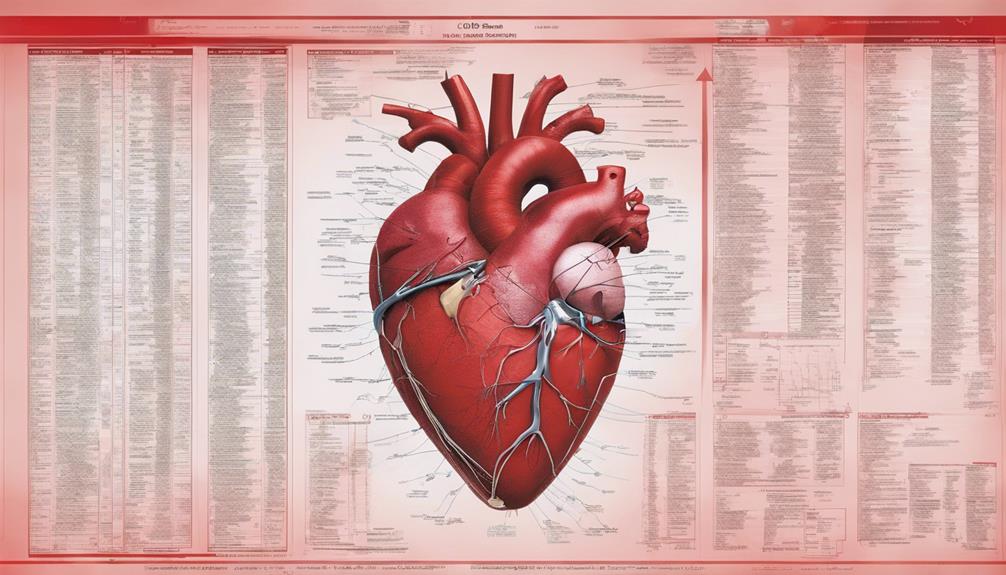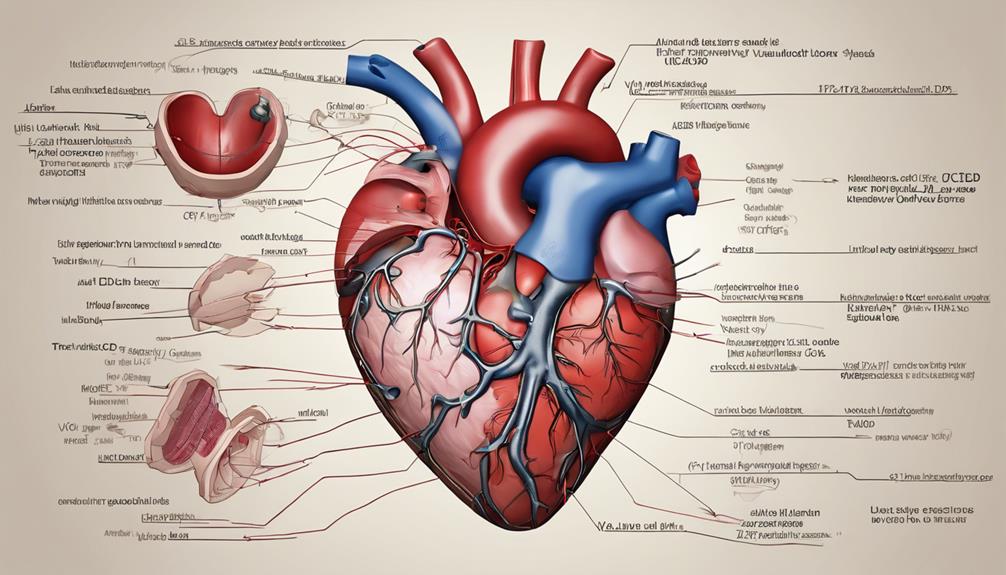As we delve into the complex composition of our bodies, picture a subtle yet revealing feature – a crease in the earlobe.
This seemingly innocuous feature has piqued the curiosity of researchers and healthcare professionals alike, hinting at a potential connection to heart disease. Could this unassuming fold hold the key to early detection and prevention of a silent threat lurking within?
Join us in unraveling the mystery behind this intriguing link between earlobe creases and cardiovascular health, as we navigate through the latest findings and implications for proactive heart care.
Key Takeaways
- DELC indicates CAD and peripheral vascular disease.
- Dermatologists play vital role in early cardiovascular issue recognition.
- Simple marker for investigating Ischemic Heart Disease.
- Early DELC detection aids in timely intervention for improved outcomes.
Earlobe Crease as Heart Disease Indicator
The presence of the diagonal earlobe crease, also known as Frank's sign, serves as a crucial indicator for identifying individuals at an elevated risk of coronary artery disease (CAD).
Studies have shown a significant association between diagonal earlobe creases and cardiovascular conditions, particularly CAD and peripheral vascular disease.
When evaluating cardiovascular risk factors, the presence of the ear lobe creases can be a visible indicator warranting further investigation. Combining the assessment of DELC with other risk factors can enhance the accuracy of predicting CAD risk.
Autopsy studies have also revealed histopathological changes in the earlobes of individuals with Frank's sign, suggesting a potential vascular link.
Dermatologists play a vital role in recognizing these ear lobe creases as early signs of cardiovascular issues, leading to timely diagnosis and intervention.
Understanding the association between diagonal earlobe creases and CAD highlights the importance of utilizing visible indicators for proactive cardiovascular health management.
Understanding the Link: Earlobe Health

Understanding the link between earlobe health and cardiovascular conditions, particularly coronary artery disease (CAD), reveals valuable insights into potential markers for identifying individuals at risk. The presence of a diagonal ear lobe crease (DELC) has been associated with an increased likelihood of developing ischemic heart disease (IHD). Studies have shown that DELC is linked to various risk factors such as hypertension, diabetes, hyperlipidemia, and high BMI. Additionally, DELC, when present alongside other signs, can indicate a higher risk of CAD and peripheral vascular disease. Research suggests that age-related changes and microvascular disease affecting elastic fibers in both earlobes and coronary arteries may contribute to the development of DELC. Clinicians can utilize DELC as a simple clinical marker for investigating IHD, especially in older individuals, which can aid in early diagnosis and intervention.
| Key Points | Details | Implications |
|---|---|---|
| DELC and CAD | DELC linked to CAD and peripheral vascular disease | Identify individuals at risk |
| Risk Factors | DELC associated with hypertension, diabetes, hyperlipidemia, high BMI | Assess overall cardiovascular risk |
| Age-Related Changes | DELC may be connected to age-related changes and microvascular disease | Understand potential mechanisms |
| Elastic Fibers | Elastic fibers in earlobes and coronary arteries affected by microvascular disease | Explore pathophysiological implications |
| Clinical Marker | DELC serves as a simple clinical marker for investigating IHD, aiding in early diagnosis and intervention | Facilitate timely medical intervention |
Diagnostic Significance of Earlobe Creases
Exploring the diagnostic significance of earlobe creases reveals a potential surrogate marker for impending Ischemic Heart Disease (IHD). When considering the presence of a diagonal earlobe crease (DELC) in individuals, it can offer valuable insights into their cardiovascular health status. Here are four key points to understand the diagnostic significance of earlobe creases:
- Association with Cardiovascular Risk Factors: Studies have shown a strong correlation between the presence of DELC and well-established cardiovascular risk factors such as hypertension, diabetes, hyperlipidemia, and high BMI.
- Indicator for Ischemic Heart Disease: DELC serves as a simple yet effective clinical marker for investigating the likelihood of developing Ischemic Heart Disease, particularly in older populations.
- Early Detection and Intervention: Detecting DELC early on can play a crucial role in timely intervention and management strategies for preventing or mitigating the risks associated with IHD.
- Risk Stratification: The presence of DELC, in conjunction with other cardiovascular risk factors, can indicate a higher predisposition towards developing coronary artery disease and Ischemic Heart Disease.
Research Insights on Earlobe Crease Connection

Research insights into the connection between earlobe creases and cardiovascular health reveal compelling genetic associations with hypertension and atherosclerosis, particularly in populations with smaller coronaries. Diagonal earlobe crease (DELC) is a significant clinical marker for impending ischemic heart disease (IHD) and is often linked to risk factors such as hypertension, diabetes, hyperlipidemia, and high BMI. Studies have shown that 95% of individuals with DELC suffer from IHD, underscoring its importance in identifying individuals at high risk for heart disease. Genetic associations between DELC and hypertension with atherosclerosis have been observed, especially among populations with smaller coronaries like the Indian population.
| Risk Factors | Clinical Marker |
|---|---|
| Hypertension | Diagonal Earlobe Crease (DELC) |
| Diabetes | Impending Ischemic Heart Disease (IHD) |
| Genetic Associations | Early Detection |
| Coronary Artery | Atherosclerosis |
Managing Cardiovascular Health With Earlobe Awareness
Our current focus shifts towards leveraging earlobe awareness as a proactive measure in managing cardiovascular health, emphasizing the crucial role of diagonal earlobe crease (DELC) as a significant indicator for potential coronary artery disease (CAD) risks.
When considering the management of cardiovascular health with earlobe awareness, it's essential to understand the following key points:
- DELC can be utilized as an independent variable in risk assessment for CAD, offering valuable insights into an individual's cardiovascular health status.
- Dermatologists can use the presence of DELC as a visual indicator to prompt further evaluation for potential cardiovascular comorbidities, aiding in early recognition and intervention.
- Research has indicated a strong correlation between the severity of DELC and the likelihood of experiencing adverse cardiac events, highlighting the importance of incorporating DELC assessment into routine clinical practice.
- Early recognition of DELC in patients enables healthcare providers to implement timely management strategies, potentially leading to improved outcomes in cardiovascular health.
Frequently Asked Questions
Is Ear Crease Linked to Heart Disease?
Yes, ear crease may be linked to heart disease. Research suggests that the presence of a diagonal earlobe crease (DELC) could indicate an increased risk of cardiovascular issues when combined with other risk factors. Understanding this connection could help in early detection and prevention strategies for heart disease.
Monitoring for DELC in conjunction with other health markers may assist in identifying individuals who could benefit from proactive heart health interventions.
How Reliable Is Frank's Sign?
Frank's Sign, also known as Diagonal Earlobe Crease (DELC), is a potential indicator of cardiovascular health. Research suggests a correlation between earlobe creases and heart disease risk factors. While not definitively established, common genetic factors may contribute to this link.
The presence of earlobe creases, when combined with other risk factors, could assist in early diagnosis of coronary artery disease. Further studies are necessary to determine the reliability of Frank's Sign in predicting heart disease.
What Does a Deep Crease in the Earlobe Mean?
When we see a deep crease in the earlobe, it often signifies more than just a mere wrinkle. This feature can serve as a potential indicator of underlying health issues.
What Is the Life Expectancy of Someone With Atherosclerosis?
Life expectancy for individuals with atherosclerosis varies based on disease severity and management effectiveness. Cardiovascular events like heart attacks and strokes can impact it. Treatment, lifestyle changes, and monitoring can improve outcomes.
Complications like coronary artery disease influence life expectancy. Early detection, intervention, and adherence to medical advice are crucial. Overall, proactive care and health maintenance positively impact the life expectancy of those with atherosclerosis.
Conclusion
In conclusion, the presence of diagonal ear lobe crease shouldn't be taken lightly as it can serve as a valuable clinical marker for impending ischemic heart disease.
By recognizing and understanding the link between earlobe health and cardiovascular risk, individuals can take proactive steps to manage their heart health.
Early detection of earlobe creases, along with other risk factors, can lead to timely intervention and improved outcomes in the prevention of heart disease.
Stay vigilant, stay healthy.









